An Improved Algorithm for Congestion Management in Network Based on Jitter and Time to Live Mechanisms
DOI:
https://doi.org/10.29194/NJES.23040352Keywords:
Congestion Control, TCP Vegas, TCP Vegas-A, Jitter, TTL, Throughput, Delay, Congestion WindowAbstract
As internet network developed rapidly in the past ten years, and its operating environment is constantly changing along with the development of computer and communication technology, the congestion problem has become more and more serious. Since TCP is the primary protocol for transport layers on the internet, the data transmitted via the transport protocol utilizes Vegas Transmission Control Protocol (TCP) as the congestion control algorithm, where it uses increasing in delay round trip time (RTT) as a signal of network congestion. However, this congestion control algorithm will attempt to fill network buffer, which causes an increase in (RTT) determined by Vegas, thereby reducing the congestion window, and making the transmission slower, Therefore Vegas has not been widely adopted on the Internet. In this paper, an improved algorithm called TCP Vegas-A is proposed consist of two parts: the first part is sending the congestion window used by the algorithm for congestion avoidance along with the TTL (Time To Live) mechanism that limits the lifetime of a packet in the network. While the second part of the algorithm is the priority-based packet sending strategy, and jitter is used as a congestion signal indication. The combination of the two is expected to improve the efficiency of congestion detection. A mathematical model is established, and the analysis of the model shows that the algorithm has better effects on controlling congestion and improving the network throughput, decreasing packet loss rate and increasing network utilization, the simulation is done using NS-2 network simulation platform environment and the results support the theoretical analysis.
Downloads
Downloads
Published
Issue
Section
License
The authors retain the copyright of their manuscript by submitting the work to this journal, and all open access articles are distributed under the terms of the Creative Commons Attribution-NonCommercial 4.0 International (CC-BY-NC 4.0), which permits use for any non-commercial purpose, distribution, and reproduction in any medium, provided that the original work is properly cited.














